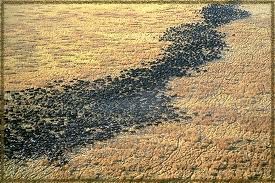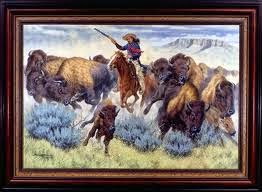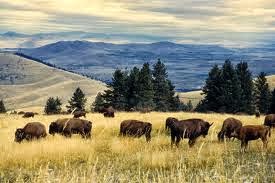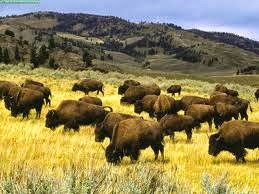 |
| “The Plains were black and appeared in motion” |
That there are actually buffalo in sufficient numbers, in New Hampshire or anywhere else, to provide meat in today’s supermarkets is a true tribute to this animal. Not a true Buffalo, it is more correctly “Bison”. That’s the name The National Bison Association want to encourage. This distinguishes this American native from the Asian Water Buffalo and the African Cape Buffalo to which it is not related. But it’s a tough sell. Buffalo is ingrained in the any history of the American West. And well it should be: this great beast was all but wiped out in one of the most ignominious slaughters in history. As the country pushed west of the Mississippi in the 1820s, ‘the plains were black and appeared in motion’ wrote an unknown contemporary writer. These were the great herds of bison whose numbers have been estimated variously between 60 and 100 million animals. Weighing up to 3500 lbs., bison had fed and clothed the Plains Indians for hundreds of years. The killing of a single male bison provided 1250 lbs. of meat. But the buffalo’s role in Native American life hardly stopped at being a foodstuff. The hide was cured and used for clothing, teepees, saddles, harnesses, lassos, and bowstrings. Tendons and sinews became thread. The hair was braided into rope, the stomachs used for cooking pots and water buckets, the bladders for rafts. Horns became spoons and ladles. Even buffalo chips were used. Called “Prairie Coal”, they provided fuel in this largely treeless landscape.
 |
| Buffalo Bill Cody hard at work |
In a matter of a very few years, the buffalo population was decimated in the west. In order to raise cattle on the land, early settlers slaughtered the free-ranging animals. As they built railroads, huge numbers of buffalo were dispensed of to secure their right of way. Once the trains ran, the Railroads hired professional gunmen who rode the rails killing any buffalo that wandered onto their tracks. Buffalo Bill Cody came by his name honestly: In one single year, working for the Union Pacific Railroad, he dispatched 4280 of the animals. But there was something even more sinister at work here. The Native Americans were so dependent on the animal that the white men believed that by eliminating it, they would eliminate the Indians themselves. If only they had studied a little harder.
 |
| Saved from extinction in the nick of time |
If the Plains Indians were proof that ‘you are what you eat’, consider these facts: They had no reported incidence of cancer. They had no reported incidence of heart disease. Their average life span was 85 to 90 years of age and when they died, it was generally from lack of dental care. They could no longer eat what had sustained them and that, of course, was buffalo. By 1906, there were 260 buffalo in all of the United States. Fortunately, government protection was finally granted the animals. Today there are well over 100,000 bison in public and private hands. Every year, 15,000 buffalo are brought to market, yielding some seven and a half million pounds of meat. They’re still concentrated in the West but they’re moving East to places like New Hampshire and New York.
Bison Meatballs in a Spicy Tomato Sauce
A wonderful take on a meatball. Made of Ground Bison and topped with a spicy tomato sauce, they're as healthy as they are delicious

Ingredients
- For the Meatballs:
- 2 lbs. Ground Bison
- 1 egg
- 1 medium onion, finely chopped
- 1 cup bread crumbs, plain
- 3 tbsp. of fresh parsley
- 1 tsp. ground black pepper
- 1/2 tsp. salt
- 2 tsp. ground basil
- 1 tsp. Worcestershire sauce
- For the Spicy Sauce:
- 6 tbsp. green relish
- 3/4 cup ketchup
- 15 ounce can tomato sauce
- 6 tbsp. finely chopped onion
- 2 tbsp. brown sugar
- 3 tbsp. Worcestershire sauce
- 3/4 cup water
- 3 tbsp. vinegar (use Balsamic if you like a sharper flavor)
- 3 tbsp. Sriracha Sauce (Optional)
- Good pinch of cracked black pepper
Directions
- Step 1 First, make the Meatballs
- Step 2 Preheat oven to 350ºF.
- Step 3 In a large bowl, add ground bison, egg, onion, parsley, bread crumbs, pepper, salt, basil and Worcestershire sauce and mix well with your hands.
- Step 4 Form into golf ball sized balls and place on an oiled cookie tray. Be careful not to overcrowd and let the meatballs touch.
- Step 5 Bake in oven 15 minutes.
- Step 6 Now make the Spicy Tomato Sauce:
- Step 7 Mix the green relish, ketchup, tomato sauce, onion, brown sugar, Worcestershire sauce, water, vinegar and cracked pepper together in a large non-stick pan.
- Step 8 Simmer over medium heat for 15 minutes, stirring frequently.
- Step 9 Add cooked meatballs and cook gently for another 10-15 minutes until meatballs are heated through.
- Step 10 Serve over spaghetti, fettucine or linguine.


